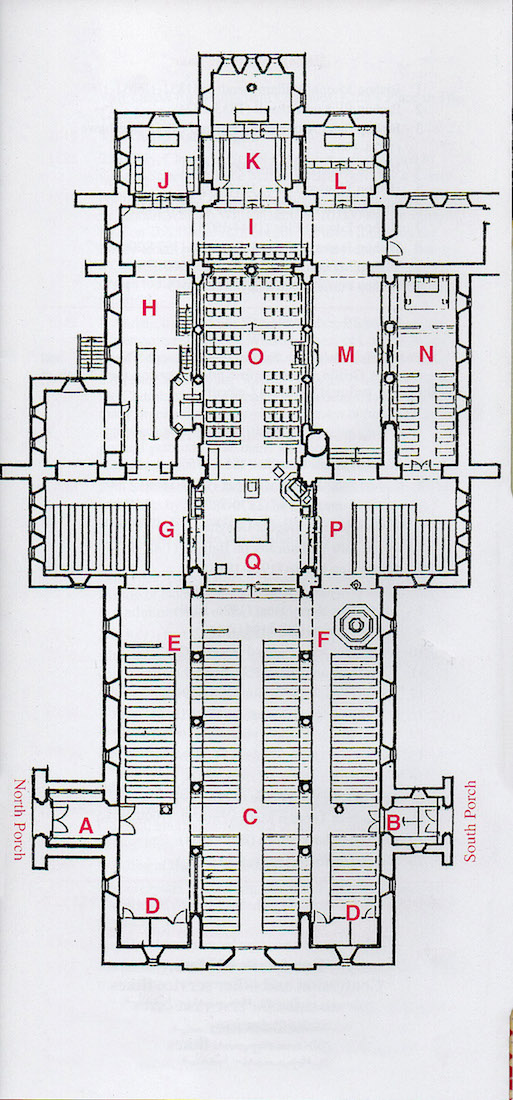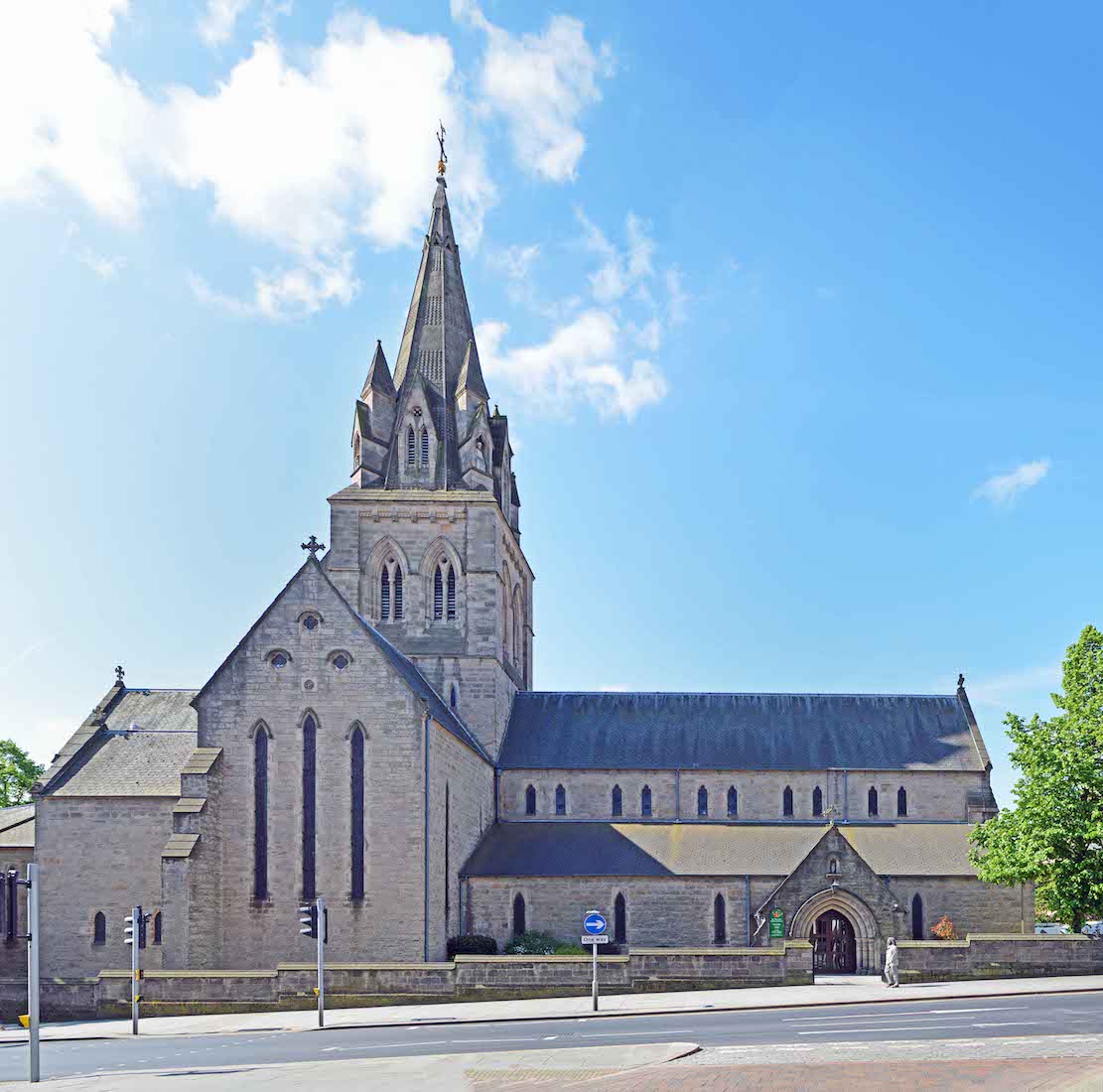WELCOME TO
NOTTINGHAM CATHEDRAL
ENGLAND CATHOLIC
PAUL SCOTT

SATELLITE VIEW
The satellite view shows that the Cathedral is inclined some 30° from an east-west axis. In this site we shall use liturgical directions with liturgical East (capital letter) at roughly east-south-east (geographical).
We see that the Cathedral is essentially cruciform in shape with a central tower, three chapels at the East end, and a further chapel adjacent to the South transept. There are two entry porches near the West end. The Cathedral Hall lies in a garden setting, and from above looks exactly like an old chapter house.
In our tour we shall start at top right, walk along North Circus Street and into the Cathedral garden, then follow a large block up College Street, returning back down Derby Street to the West wall (top left), look at the North wall, and finally enter the Cathedral through the North porch.

This is the plan from the Cathedral guide. We shall enter the Cathedral through the North porch (A), exploring the nave C with its confessionals (D) at the West end, and baptismal font (F). We then look at the sanctuary/chancel (Q/O), North transept (G) and South transept (P).
From here we move to the ornate Blessed Sacrament Chapel (N), and follow the South ambulatory (M) up to the Southeast Chapel (L). The East ambulatory (I) then takes us to the Lady Chapel (K) and the Unity Chapel (J). Finally there is the North Ambulatory (H) which leads us to the organ and the lovely rose window (O).
A brief history of the Cathedral is given below. However, if you want to proceed immediately with the tour, tap / click on START .
You can access intermediate points in the tour by a tap / click on the following links:
NOTE ON MAGNIFYING IMAGES
With this website format the images are large enough for most purposes. If there is a need for greater magnification of an image, go to the identical photo on
https://www.flickr.com/photos/paulscottinfo/albums
and use Command - + (Mac) or Windows - + (Windows).
HISTORY
[Wikipedia]
The Cathedral Church of St. Barnabas in the city of Nottingham, England, is a cathedral of the Roman Catholic church. It is the mother church of the Diocese of Nottingham and seat of the Bishop of Nottingham.
It is located on the corner of Derby Road and North Circus Street, on the opposite side of which are the Albert Hall and the Nottingham Playhouse (Wellington Circus).
It was built between 1841 and 1844, costing £15,000 (equivalent to £1,510,000 in 2019), and was first consecrated in 1844, fifteen years after the Catholic Relief Act ended most restrictions on Catholicism in the United Kingdom. A substantial amount of the cost was paid by the important Catholic Lord Shrewsbury. The architect was Augustus Welby Northmore Pugin who also designed the interior of The Houses of Parliament. It was built in the Early English Plain Gothic style, although in contrast, the Blessed Sacrament Chapel was richly decorated and Pugin’s later churches were built in that Decorated Gothic style throughout. Pugin was retained as architect by Rev Robert William Willson, then priest in charge of Nottingham. In 1842 he was named as Bishop-Elect of Hobart, Tasmania, and had to leave the work in Nottingham before completion.
Following the establishment of a new Catholic hierarchy in England and Wales in 1850 by the decree of Pope Pius IX, it was raised to cathedral status in 1852, becoming one of the first four Catholic cathedrals in England and Wales since the English Reformation. It is the seat of the Bishop of Nottingham.
The cathedral is a Grade II* listed building of the lancet style of architecture, and is considered to be one of the best specimens of Pugin’s work. Most of Pugin’s decorative scheme was destroyed in the upheaval that surrounded the Second Vatican Council, when the old high altar was discarded, and most of the painted decoration smothered and painted plain. Other fittings removed at this time include the old cathedra, as well as the figures of St Mary and St John from the rood screen (the figures were reinstated in 1993). Buildings of England wrote: ‘The whole effect could hardly be further from the richness of decoration and atmosphere that Pugin intended’. A fragment of the scheme is preserved in the Blessed Sacrament chapel, and is the highlight of the interior. The replacement high altar from the 1960s was replaced again in 1993 with one in a more sympathetic style. Fragments of Pugin’s decoration, such as the roundels in the nave, were uncovered and restored, but most remain lost.
The clergy of the Cathedral also serve the church of St. Augustine on Woodborough Road.
https://en.wikipedia.org/wiki/Nottingham_Cathedral



